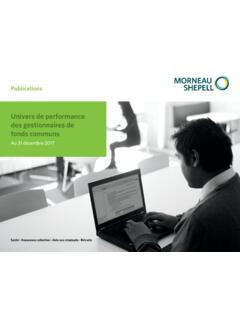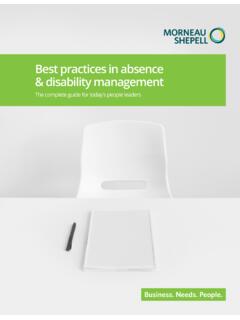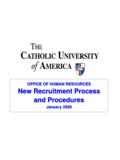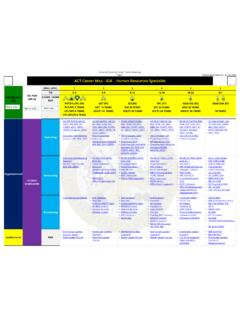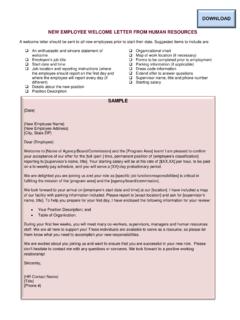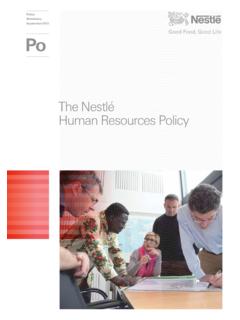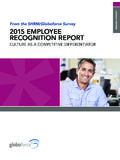Transcription of Human Resources Trends for 2018 - Morneau Shepell
1 Human Resources Trends for 2018 . Insights on what HR leaders are expecting in the coming year Comprehensive report September 2017. Table of contents 1 Executive Summary 3 HR priorities for 2018 . 6 Expected changes in compensation 8 Improving health, engagement and productivity 11 Reducing the cost of absence and disability 13 Optimizing retirement plans 17 Appendix: Detailed results of survey 17 Organizational profile 18 Priorities for 2018 . 19 Compensation 22 Workplace health and engagement 23 Absence and disability management 24 Retirement and savings plans 26 Other retirement benefits Executive Summary Morneau Shepell 's annual Trends in Human Resources survey canvasses Canadian employers on what they are planning for the coming year, and asks HR Leaders about the opportunities and challenges they face. This year's survey suggests they are cautiously optimistic about the coming year, and are focused on building high performing and resilient workforces.
2 Highlights of the survey include: Human Resources (HR) leaders identified their top three areas of interest as improving employee engagement (65%), attracting and retaining employees with the right skills (56%), and helping their organizations adapt better to ongoing change (55%). Almost half (47%) of respondents said that improving the physical and/or mental health of their workforce was also a priority for the coming year. HR leaders want to spend more time delivering value, and less time on tactical activities. Forty-three per cent (43%) said that streamlining the administration of HR programs was a key priority for 2018 . HR leaders also identified other ways for reducing costs and improving efficiency. Two of the top five targets for cost reduction in 2018 are reducing short-term disability costs (40%) and long-term disability costs (38%). Salaries are expected to rise by an average of in Canada in 2018 , up from in 2017.
3 This higher number likely reflects optimism about the coming year: 92% of respondents indicated financial performance in 2018 . was likely to be the same or better than in 2017. Despite this optimism, employers are still cautious about salary increases, perhaps reflecting a concern that rising interest rates may dampen economic growth next year. More than a third (37%) of HR leaders identified complex mental health claims as their top challenge in managing absence and disability costs. Almost two-thirds (65%) saw better training for their managers as a key strategy for improving disability management. In dealing with mental health, HR leaders saw a lack of knowledge on the part of managers (58%), lack of knowledge on the part of employees (55%), and stigma (55%) as their top challenges. Human Resources Trends for 2017, Insights on what HR leaders are expecting in the coming year | September 2016 1. The survey also picked up some important changes in attitudes toward retirees.
4 As employers move away from defined benefit retirement plans, 91% of HR leaders said they were concerned about the financial preparedness of their employees for retirement. Along with education, there is a growing interest in providing decumulation and health insurance options for retirees. The results of the survey are discussed in greater detail in the body of this report, as are the results of related research in these areas and a review of tools and services that may be helpful in HR planning for 2018 . Morneau Shepell 's 35th annual Trends in Human Resources survey was conducted in June and July 2017, with input from 370 organizations employing 894,000 Canadians in a broad cross-section of industry sectors. HR Trends for 2018 , Insights on what HR leaders are expecting in the coming year | September 2017 2. HR priorities for 2018 . Building a high-performing and resilient workforce is a priority for employers HR leaders identified their top three areas of interest as improving employee engagement (65%), attracting and retaining employees with the right skills (56%), and helping their organizations adapt better to ongoing change (55%).
5 The rapid pace of change is a challenge to organizations as they reconsider traditional approaches to Human capital management. HR Leaders are looking for ways to build more resilient workforces - the most successful organizations will be those that can adapt best to change. To build more resilient workforces, HR leaders are implementing a range of solutions including training employees to have stronger coping skills, and providing better tools and training for managers to ensure that employees facing challenges get the help they need. Almost half (47%) of respondents said that improving either physical and/or mental health was also a priority for the coming year. This response with respect to mental health was an increase from 41% in last year's survey, highlighting the growing importance of a proper mental health strategy and support tools in overall HR planning. Table A. Top 5 priorities for improving health, engagement and productivity in 20187 % who see this as a priority Improve employee engagement 65%.
6 Improve attraction and retention of employees with the right skills 56%. Help the organization adapt better to ongoing change 55%. Improve learning and development programs 48%. Improve the physical and/or mental health of employees 47%. HR Trends for 2018 , Insights on what HR leaders are expecting in the coming year | September 2017 3. Additional insights: Research from Morneau Shepell 's Mental Health Priorities: 2016, indicated that organizational change is a potential risk to employee health, engagement and productivity. Forty-three per cent (43%) of employees indicated that the most recent organizational change negatively impacted their perception of the company, while 40% stated that it negatively impacted their health and well-being. Further, 40% saw more co-worker absenteeism following an organizational change, and 17% indicated that they took more time off work themselves. These insights make it clear that organizations need to increase their attention to the Human aspect of organizational change or risk diminishing the anticipated benefits of change.
7 A critical step is to invest in the capabilities of people managers. Absence management and streamlining HR administration continue to be focus areas to reduce costs and improve productivity The survey showed that employers are also looking for ways to improve efficiency and reduce costs. Forty-three per cent (43%) of survey respondents reported that streamlining the administration of HR programs is a key priority for 2018 . HR leaders clearly want to spend more time delivering value to their business stakeholders and less time on tactical activities that have minimal impact. In addition to streamlining administration, employers are seeking ways to reduce costs and improve efficiencies in the area of absence and disability management. Their priorities include: reducing short-term disability costs (40%), reducing long-term disability costs (38%), reducing workers' compensation costs (29%), and reducing the cost of incidental absence (27%).
8 Table B. Top 5 priorities for reducing costs and improving efficiency in 2018 % who see this as a priority Streamline administration of HR programs 43%. Reduce short-term disability costs 40%. Reduce employee turnover 39%. Reduce long-term disability costs 38%. Reduce the cost of health and dental plans 32%. HR Trends for 2018 , Insights on what HR leaders are expecting in the coming year | September 2017 4. Additional insights: According to Statistics Canada's Work Absence Statistics of Full-Time Employees, 2016, the total days lost per worker in 2016 for the private sector had rebounded to 2012 levels after declining in 2013 2015. The 2016. rate for public sector workers was actually higher than in 2012. This suggests that more attention needs to be paid to both the typical and emerging drivers of absenteeism, as well as the manner in which absences are managed. Given these numbers, it is not surprising that this year's HR Trends survey shows a concern among employers regarding the direct cost of employees' absence.
9 In addition, work absence is a source of productivity loss, as well as a loss of skill and experience. Given increasingly competitive market conditions, such losses can have significant impact on organizations and their potential for growth. A problem-solving approach to absence management, rather than a solely administrative one, is critical to addressing the issue of employee absence in a sustainable way. The strategic use of technology is fundamental to streamlining processes, getting better reports and insights and improving problem solving. Employers are focusing in two main areas: engaging employees and supervisors with the support of a skilled case manager, and removing systematic barriers by providing access to recovery support services for mental health conditions. You may also want to read: The true picture of workplace absence Best practices in absence & disability management Solutions to consider: Abiliti: Absence and Disability Management software Optimizing your disability management strategy with InfluenceCare HR Trends for 2018 , Insights on what HR leaders are expecting in the coming year | September 2017 5.
10 Expected changes in compensation Salaries expected to increase by per cent in 2018 . Employers in Canada are expecting salaries to rise by an average of in 2018 . This is up from a average increase in salaries for 2017. The survey identified some industry sectors that are expecting higher-than-average salary increases in 2018 . They include utilities at , and manufacturing and wholesale trade at These industries may be catching up after lower-than-average increases over the past few years. Lower-than-average increases are expected in certain industry groups that face more uncertain economic circumstances. They include mining and oil and gas extraction where average salary increases of are expected. Salary increases in the public sector are also expected to be below average. Table C. Actual 2017 increases Expected 2018 increases Compensation changes by industry as a % of payroll as % of payroll Arts, Entertainment and Recreation Educational Services Finance and Insurance Health Care and Social Assistance Manufacturing Mining and Oil and Gas Extraction Other services (except Public Administration) Professional, Scientific and Technical Services Public Administration Retail Trade Transportation and Warehousing Utilities Wholesale Trade Utilities National average Reflecting the mix of industries in the provinces, Alberta is expected to have the lowest salary increases next year, at , followed by Prince Edward Island and the Territories at In contrast, Quebec is expecting higher-than- average increases in the range.

